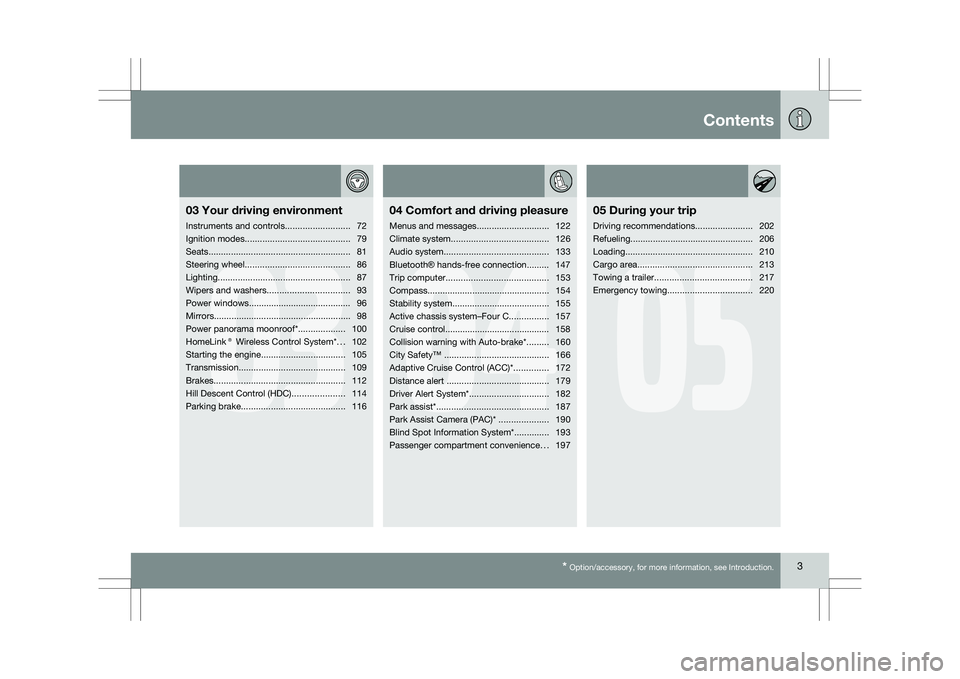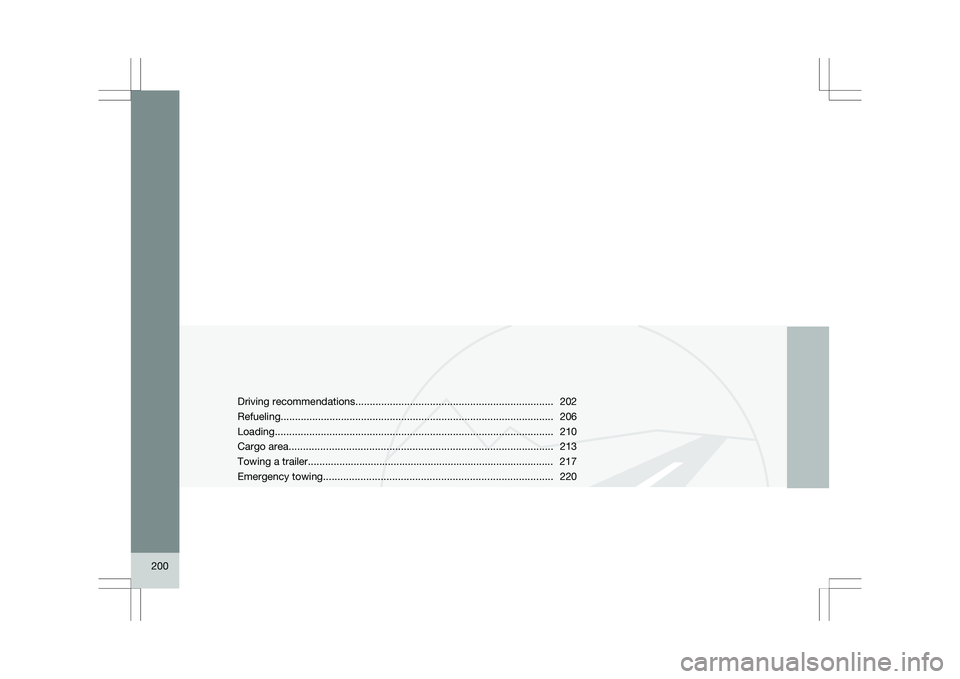2009 VOLVO XC60 emergency towing
[x] Cancel search: emergency towingPage 5 of 297

Contents* Option/accessory, for more information, see Introduction. 3
03
03
Your driving environment
Instruments and controls ..........................72
Ignition modes .......................................... 79
Seats......................................................... 81
Steering wheel .......................................... 86
Lighting ..................................................... 87
Wipers and washers................................. 93
Power windows......................................... 96
Mirrors....................................................... 98
Power panorama moonroof*................... 100
HomeLink® Wireless Control System* ...102
Starting the engine .................................. 105
Transmission ........................................... 109
Brakes..................................................... 112
Hill Descent Control (HDC) .....................114
Parking brake .......................................... 116
04
04Comfort and driving pleasure
Menus and messages .............................122
Climate system ....................................... 126
Audio system.......................................... 133
Bluetooth ® hands-free connection......... 147
Trip computer......................................... 153
Compass................................................. 154
Stability system....................................... 155
Active chassis system–Four C ................157
Cruise control.......................................... 158
Collision warning with Auto-brake*......... 160
City Safety™ .......................................... 166
Adaptive Cruise Control (ACC)* ..............172
Distance alert ......................................... 179
Driver Alert System*................................ 182
Park assist*............................................. 187
Park Assist Camera (PAC)* .................... 190
Blind Spot Information System*.............. 193
Passenger compartment convenience ...197
05
05 During your trip
Driving recommendations .......................202
Refueling ................................................. 206
Loading ................................................... 210
Cargo area .............................................. 213
Towing a trailer ....................................... 217
Emergency towing .................................. 220
Page 202 of 297

200 Driving recommendations
..................................................................... 202
Refueling ........................................................................\
....................... 206
Loading ........................................................................\
......................... 210
Cargo area ........................................................................\
.................... 213
Towing a trailer
........................................................................\
.............. 217
Emergency towing ........................................................................\
........ 220
Page 222 of 297

05 During your tripEmergency towing 05
220 Towing eyelet
Location of the towing eyelet
Attaching the towing eyelet
The towing eyelet is located under the floor of
the cargo area, with the spare tire. This eyelet
must be screwed into the positions provided on the right sides of either the front or rear
bumper (see illustration).
CAUTION If the vehicle is being towed on a flat bed
truck, the towing eyelets must not be used
to pull the vehicle up onto the flat bed.
NOTE
On certain models equipped with a trailer
hitch, the towing eyelet cannot be screwed
into the hole in the rear bumper. The towing
rope should be attached to the trailer hitch
instead. For this reason, the detachable
section of the trailer hitch should be safely
stowed in the vehicle at all times.
Attaching the towing eyelet
Use a coin to pry open the lower edge of
the cover.
Screw the towing eyelet in place, first by
hand and then using the tire iron until it is
securely in place.
After the vehicle has been towed, the eyelet
should be removed and returned to its storage
location. Press the cover for the attachment point back
into position.
WARNING If the vehicle has no electrical current and
must be towed, the power steering and
brake systems will not function normally. It
will still be possible to steer the vehicle and
apply the brakes. However, keep in mind
that greater effort will be required to turn the
steering wheel and depress the brake pedal.
Precautions when the vehicle is in tow
\b
The steering wheel must be unlocked. The
remote key must be in the ignition slot 1
.
\b Attach jumper cables (see page 107) to
provide current for releasing the optional
electric parking brake and to move the gear
selector from the
P position.
\b The gear selector must be in position
N.
\b Maximum speed: 50 mph (80 km/h). Do not
exceed the maximum allowable towing
speed.
\b Maximum distance with front wheels on
ground: 50 miles (80 km).
\b While the vehicle is being towed, try to
keep the tow rope taut at all times.
\b The vehicle should only be towed in the
forward direction. 1
On vehicles with the optional keyless drive, the remote key must be in t\
he passenger compartment. G031971
Page 223 of 297

05 During your trip
Emergency towing05
221
NOTEDuring towing, ignition mode
II should be
used so that the lighting can be switched on.
CAUTION Vehicles with AWD (All Wheel Drive) with the
front wheels off the ground should not be
towed at speeds above 50 mph (70 km/h) or
for distances longer than 30 miles (50 km).
CAUTION
\b
Please check with state and local
authorities before attempting this type
of towing, as vehicles being towed are
subject to regulations regarding maxi-
mum towing speed, length and type of
towing device, lighting, etc.
\b If the vehicle\fs battery is dead, do not
attempt to start the vehicle by pushing
or pulling it as this will damage the
three-way catalytic converter(s). The
engine must be jump started using an
auxiliary battery (see page 107).
\b If the vehicle is being towed on a flat bed
truck, the towing eyelets must not be
used to pull the vehicle up onto the flat
bed or to secure the vehicle on the flat
bed. Consult the tow truck operator.
Towing vehicles with front wheel drive/
All Wheel Drive
Volvo recommends the use of flat bed equip-
ment.
\b
If wheel lift equipment must be used,
please use extreme caution to help avoid
damage to the vehicle.
In this case, the
vehicle should be towed with the rear
wheels on the ground if at all possible.
\b If it is absolutely necessary to tow the vehi-
cle with the front wheels on the ground,
please refer to the towing information on
page 220.
CAUTION \b
Sling-type equipment applied at the
front will damage radiator and air con-
ditioning lines.
\b It is equally important not to use sling-
type equipment at the rear or apply lift-
ing equipment inside the rear wheels;
serious damage to the rear axle may
result.
\b If the vehicle is being towed on a flat bed
truck, the towing eyelets must not be
used to secure the vehicle on the flat
bed. Consult the tow truck operator.
Page 292 of 297

07 Index07
290 Dual Xenon headlights
...............................88
E ECC.................................................. 129, 130
Economical driving
.................................. 202
Electric parking brake ..............................116
Electronic Climate Control .......128, 129, 130
air distribution table ............................131
Interior Air Quality System.................. 130
Emergency brake lights .............................88
Emergency locking retractor
...................... 34
Emergency starting .................................. 107
Emergency towing ........................... 220, 221
Emission inspection readiness ................225
Engine overheating ........................................... 77
specifications ...................................... 283
starting ................................................ 105
starting with keyless drive ..................106
Engine compartment overview ................227
Engine oil checking ............................................. 228
low pressure warning light ....................75specifications
...................................... 283
volumes .............................................. 284
Environment ................................................. 9
Eyelets for anchoring loads .....................210
F Federal Clean Air Act
...............................224
Fluid specifications .................................. 285
Fog lights front...................................................... 75
front, changing bulbs ..........................236
front/rear............................................... 89
rear......................................................
236
Four C (active chassis system) ................157
Front airbags.................................. 18, 19, 20 disconnecting passenger’s side air-
bag.................................................. 22, 23
Front fog lights ..................................... 75, 89
changing bulbs ................................... 236
Front park assist.............................. 187, 189
Front seats ........................................... 81, 82
Fuel filler cap............................................ 208
Fuel filler door, opening ...........................208Fuel level warning light
..............................75
Fuel requirements ............................ 206, 207
Fuel tank volume
...................................... 285
Fuses............................... 245, 246, 249, 251
G Gasoline requirements
.............................207
Gas tank volume...................................... 285
Gauges...................................................... 73
Geartronic ................................................ 110
Geartronic automatic transmission
.. 109, 110
Generator warning light .............................76
Glossary of tire terminology .....................260
Grocery bag holder.................................. 211
Gross vehicle weight ............................... 261
H Hazard warning flashers
............................89
HD digital radio ........................................ 139